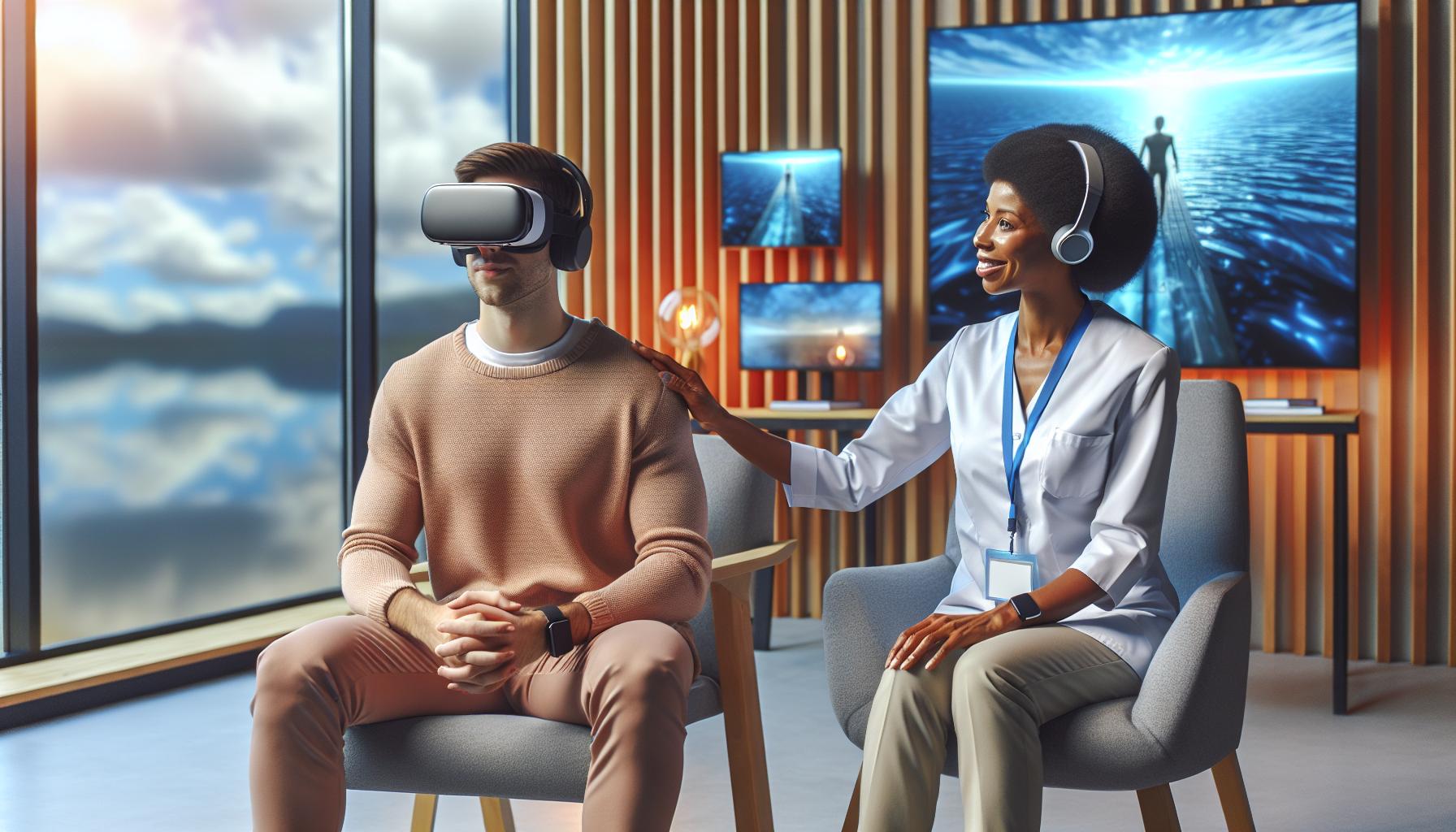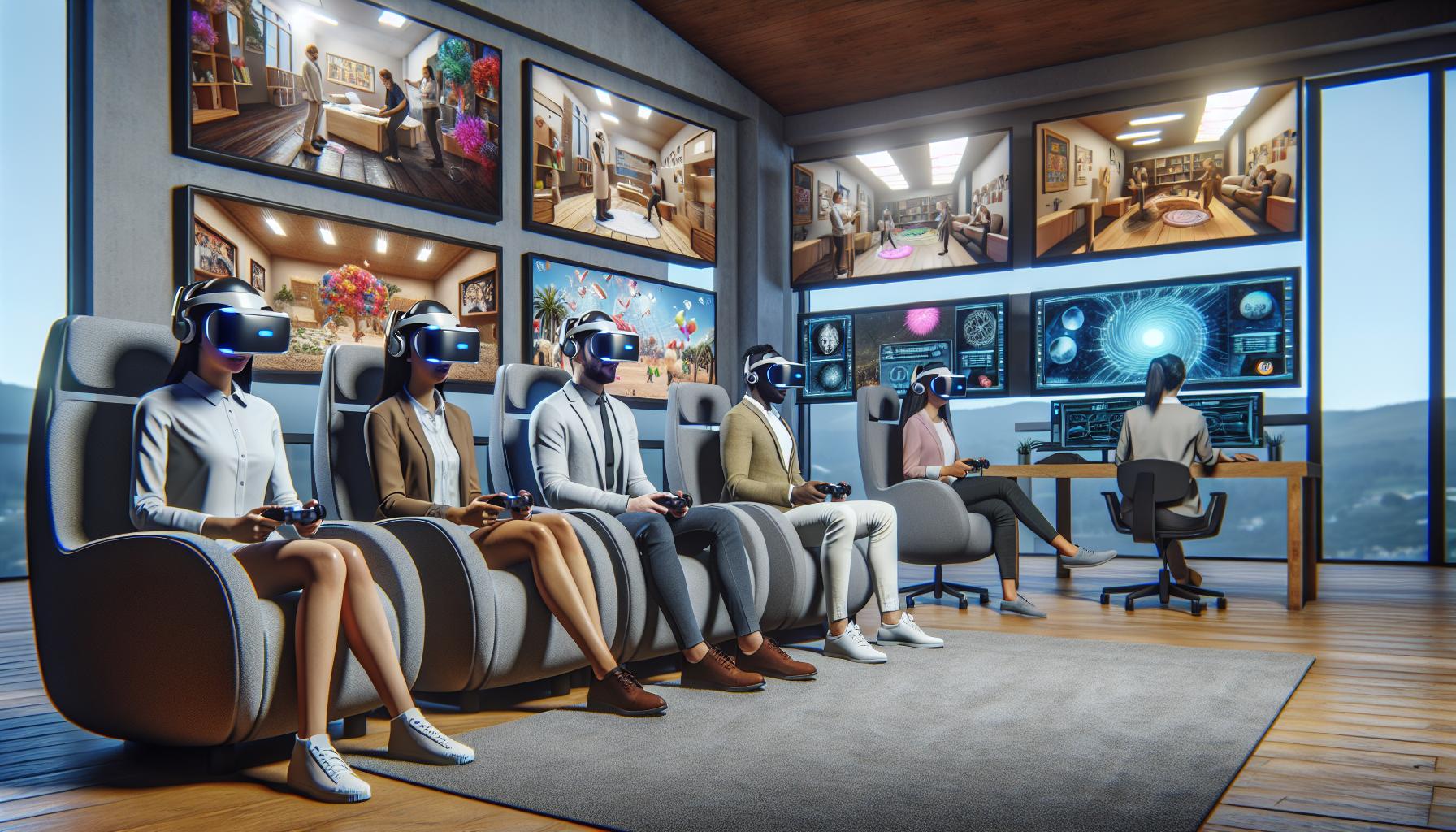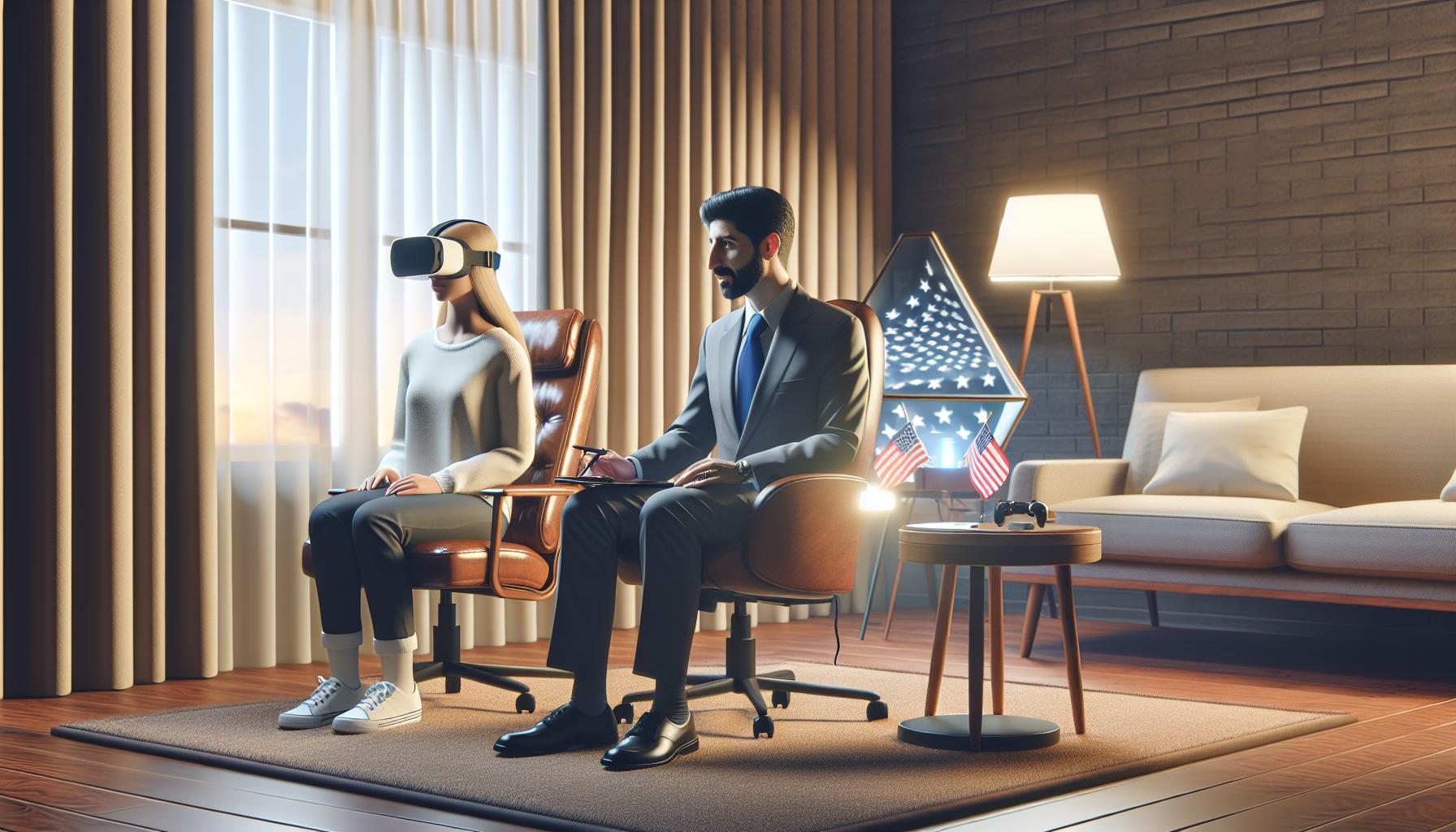Ever wondered what it’s like to face your fears in a completely safe environment? Virtual Reality Exposure Therapy (VRET) makes this possible by combining cutting-edge technology with proven therapeutic techniques. This innovative approach helps people confront and overcome their anxieties without leaving the comfort of their therapist’s office.
Think of VRET as a high-tech security blanket that lets you tackle your fears head-on. Whether it’s a fear of heights, public speaking, or even spiders, this groundbreaking treatment creates realistic simulations that feel incredibly real – minus the actual danger. By gradually exposing patients to their phobias in a controlled virtual environment, therapists can help them develop better coping mechanisms and build confidence in real-world situations.
What is Virtual Reality Exposure Therapy
Virtual Reality Exposure Therapy delivers immersive digital environments for psychological treatment through specialized hardware and software. This therapeutic approach combines traditional exposure therapy principles with advanced virtual reality technology.
How VRET Works
VRET creates controlled digital scenarios that replicate anxiety-triggering situations in a safe environment. The therapist gradually adjusts exposure intensity based on the patient’s comfort level, allowing systematic desensitization to occur. Patients wear VR headsets to experience 3D simulations while receiving real-time guidance from their therapist. The virtual environments respond to patient movements, creating an authentic sense of presence that triggers genuine emotional responses.
Key Components and Technology
Modern VRET systems integrate high-resolution displays, motion tracking sensors, haptic feedback devices. The core hardware includes VR headsets with 90-120Hz refresh rates, position-tracking cameras, hand controllers. Essential software components feature realistic 3D graphics engines, behavioral monitoring systems, customizable environment controls. Professional VRET platforms incorporate biometric sensors that measure heart rate, skin conductance, eye movements to track patient responses. Integration capabilities allow therapists to modify scenarios in real-time through dedicated control interfaces.
Benefits of Virtual Reality Exposure Therapy

Virtual Reality Exposure Therapy (VRET) offers significant therapeutic advantages compared to traditional exposure methods. The technology enhances treatment outcomes through customizable virtual environments that address specific patient needs.
Control and Safety
VRET provides therapists complete control over exposure scenarios in a risk-free digital environment. Patients experience anxiety-triggering situations without physical danger while therapists adjust intensity levels based on individual progress. The virtual environment pauses or modifies instantly when patients show signs of distress, preventing overwhelming experiences. Digital simulations eliminate unpredictable variables found in real-world exposure settings, such as weather conditions or unexpected triggers. Therapists monitor patient responses through data analytics tools that track heart rate, movement patterns, and stress indicators.
Cost-Effectiveness and Accessibility
VRET reduces treatment expenses by eliminating travel costs to real exposure locations. A single VR system serves multiple patients with different phobias through various digital scenarios. Remote therapy sessions enable patients in rural areas to access specialized treatment without long-distance travel. The initial setup costs offset traditional exposure therapy expenses like rental spaces or live animals for phobia treatment. Healthcare providers maximize resource utilization by treating more patients in less time using preset virtual environments. Insurance companies increasingly cover VRET sessions, making advanced treatment accessible to broader patient populations.
Common Applications and Uses

Virtual Reality Exposure Therapy demonstrates significant effectiveness across multiple psychological conditions. Healthcare professionals apply VRET in various clinical settings to address specific mental health challenges through controlled digital environments.
Treating Anxiety Disorders
VRET addresses social anxiety disorder through simulated social interactions in virtual environments. Patients experience scenarios such as job interviews, classroom presentations or crowded public spaces under therapeutic supervision. Digital environments recreate anxiety-triggering situations like public speaking platforms with virtual audiences of 10-50 people. The therapy incorporates progressive exposure levels, starting with small groups before advancing to larger crowds. Therapists customize anxiety-inducing elements including audience reactions, environmental sounds or time pressure to match each patient’s therapeutic needs. Real-time monitoring allows clinicians to adjust scenario intensity based on patient responses measured through heart rate variability data points.
Managing PTSD and Phobias
VRET creates immersive environments for treating combat-related PTSD, specific phobias or trauma responses. Military veterans engage with controlled combat simulations while civilians confront traumatic events in safe digital spaces. The platform generates specific phobic stimuli such as heights (30-100 feet elevations), enclosed spaces (5×5 foot rooms) or animals (spiders, snakes, dogs). Treatment protocols typically involve 8-12 sessions lasting 45-60 minutes each. Success rates show 70-80% of patients experience reduced symptom severity after completing VRET programs. Insurance data indicates PTSD patients require 40% fewer sessions compared to traditional exposure therapy methods.
The Treatment Process

Virtual reality exposure therapy follows a structured approach that combines psychological assessment with customized treatment planning. Each phase builds upon the previous one to create a comprehensive therapeutic experience.
Assessment and Planning
The initial assessment phase begins with a thorough evaluation of the patient’s symptoms, triggers, and medical history. A qualified therapist conducts standardized psychological tests to measure anxiety levels and determine specific phobia characteristics. The evaluation includes:
- Digital questionnaires measuring anxiety severity
- Medical screening for VR compatibility
- Trigger identification through behavioral analysis
- Treatment goal setting with measurable outcomes
- Creation of personalized exposure hierarchies
Session Structure and Duration
VRET sessions maintain a consistent format to maximize therapeutic benefits. A typical session lasts 45-60 minutes with specific time allocations:
- 10 minutes for pre-exposure preparation
- 20-30 minutes of active VR exposure
- 15 minutes for post-session processing
- 5 minutes for homework assignment
Treatment protocols span 8-12 sessions across 6-8 weeks. Each session incorporates:
- Vital sign monitoring at 5-minute intervals
- Real-time anxiety level assessments
- Progressive exposure intensity adjustments
- Coping strategy implementation
- Documentation of behavioral responses
The therapist maintains continuous communication through a microphone system, providing guidance throughout the virtual experience. Between sessions, patients complete practice exercises using mobile VR applications or visualization techniques.
Success Rates and Clinical Evidence
Clinical studies demonstrate VRET’s effectiveness across multiple psychological conditions with success rates ranging from 68% to 91%. Research published in the Journal of Clinical Psychology shows VRET achieves comparable or superior outcomes to traditional exposure therapy.
| Condition | Success Rate | Treatment Duration |
|---|---|---|
| Specific Phobias | 91% | 8-10 sessions |
| Social Anxiety | 85% | 10-12 sessions |
| PTSD | 78% | 12-15 sessions |
| Panic Disorder | 68% | 8-12 sessions |
Meta analyses from 2019-2023 reveal persistent therapeutic gains, with 75% of patients maintaining improvements 12 months post treatment. Studies conducted at prominent institutions like Stanford University Virtual Human Interaction Lab indicate VRET reduces anxiety symptoms by 60-80% compared to baseline measurements.
Randomized controlled trials demonstrate VRET’s particular efficacy in treating:
- Aerophobia patients reporting 89% reduction in flight anxiety
- Combat veterans experiencing 71% decrease in PTSD symptoms
- Social anxiety sufferers showing 82% improvement in public speaking confidence
- Height phobia cases achieving 90% fear reduction after exposure
Research validates VRET’s cost effectiveness, with patients requiring 40% fewer sessions than conventional therapy methods. The American Journal of Psychiatry reports 85% of VRET patients maintain therapeutic gains without additional treatment for 3 years post therapy completion.
Clinical evidence supports VRET’s physiological impact through measurable reductions in heart rate, blood pressure, cortisol levels during exposure sessions. Brain imaging studies confirm decreased amygdala activation patterns following successful VRET treatment protocols.
Limitations and Challenges
Technical barriers impact VRET implementation, with high-end VR systems costing $2,000-$5,000 per setup. Limited internet bandwidth in rural areas restricts access to cloud-based VRET platforms that require 25+ Mbps connections for optimal performance.
Motion sickness affects 15-20% of VRET patients during initial sessions, manifesting as:
- Dizziness lasting 30-45 minutes post-session
- Nausea during rapid virtual movements
- Visual strain from extended headset use
Hardware limitations create therapy restrictions:
- Battery life spans only 2-3 hours per charge
- Headset weight averages 470-600 grams causing neck strain
- Field of view ranges 90-110 degrees versus natural 180 degrees
Insurance coverage remains inconsistent, with 65% of providers classifying VRET as experimental treatment. Clinical standardization poses challenges due to varying VR platform capabilities across treatment centers.
| Technical Limitation | Impact on Treatment |
|---|---|
| Motion Tracking Lag | 20-40ms delay in response time |
| Graphics Resolution | 1832 x 1920 pixels per eye maximum |
| Wireless Range | 5-7 meters from base station |
| Setup Time | 15-20 minutes per session |
Privacy concerns exist regarding data collection through embedded sensors tracking:
- Eye movements
- Heart rate patterns
- Motion data
- Voice recordings
Integration challenges with existing electronic health records limit seamless documentation of VRET sessions. Software compatibility issues between different VR platforms restrict content sharing among treatment facilities.
Advancement in Mental Health Treatment
Virtual Reality Exposure Therapy stands as a groundbreaking advancement in mental health treatment. Its blend of cutting-edge technology and proven therapeutic principles offers new hope for individuals struggling with anxiety phobias and PTSD.
The impressive success rates coupled with reduced treatment times and long-term effectiveness make VRET a compelling choice for both therapists and patients. While challenges exist with technology and implementation the benefits far outweigh the limitations.
As VR technology continues to evolve VRET’s role in mental health treatment will likely expand providing more accessible and effective solutions for those seeking help with psychological challenges.



